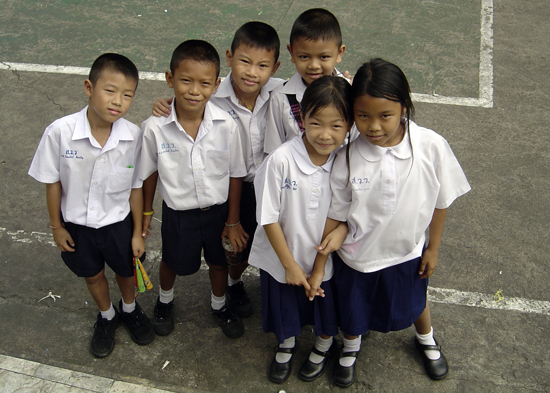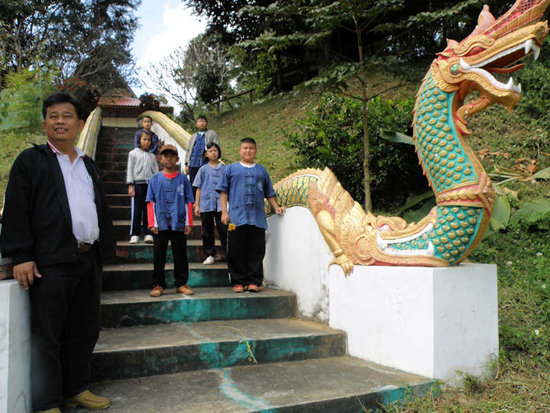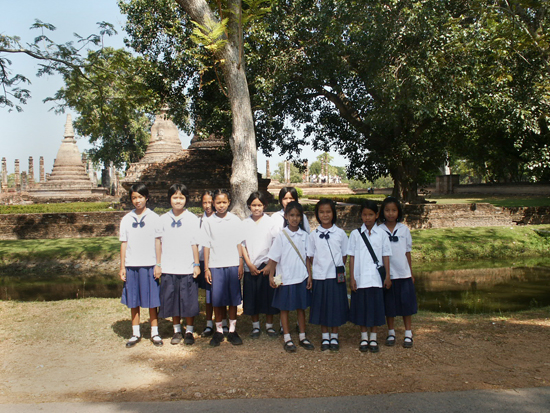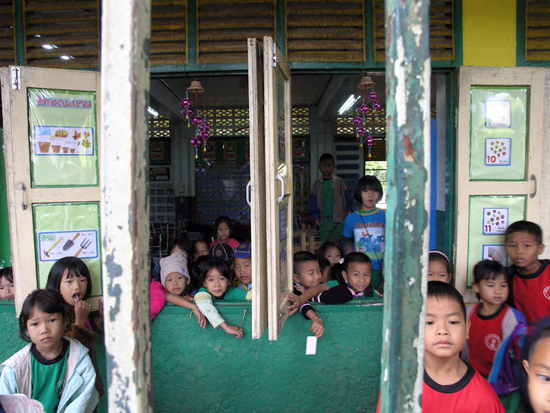Education: Education Structure
Introduction
Thai children have nine years of compulsory teaching, lasting between the ages of 6 and 14 years. Girls and boys are educated together with the language of instruction at state schools being Thai.
Pupils of all ages are required to wear school uniforms. Generally, boys wear a white dress shirt and a pair of shorts. Girls usually wear a white blouse and a skirt. The skirts vary in color and length depending upon the school and the student’s age. Generally the younger students wear long skirts that almost reach their ankles and the older students wear shorter ones.
Formal Structure of the School System
Primary
Type of school providing this education: Primary schools
Length of program: 6 years
Age: 6 to 11 years
Certificate/diploma awarded: Primary school certificate
Lower Secondary
Type of school providing this education: Secondary schools
Length of program: 3 years
Age: 12 to 14 years
Certificate/diploma awarded: Lower secondary school certificate
Upper Secondary
Type of school providing this education: Secondary schools
Length of program: 3 years
Age: 15 to 17 years
Certificate/diploma awarded: Upper secondary school certificate (Matthayom Suksa 6)
The education system is structured with six years of compulsory primary school and three years of lower secondary education. The school structure is divided into four key stages. The first three years in elementary school (Prathom 1 to 3) are for ages six to eight years. The second level (Prathom 4 to 6) is for ages 9 to 11, and the third level (Matthayom 1 to 3) is for 12- to 14-year-olds. This completes the compulsory schooling and students can leave with a lower secondary school certificate at this stage.
The upper secondary level of schooling is optional and consists of Matthayom 4 to 6 for ages 15 to 17 years. Admission to an upper secondary school is through an entrance exam. At this level, schools are divided into two major tracks: general/academic and vocational. At the end of upper secondary school, pupils sit for the upper secondary school certificate (Matthayom Suksa 6) exam.
Upon graduating from high school, students need to pass the CUAS (Central University Admission System) in order to enter higher education. This consists of a combination of their upper secondary school grade point average (GPA) and a general aptitude test (GAT), which covers reading, writing, analytical thinking, problem solving, and English communication. Currently, students can sit the GAT up to three times with their best scores counting.
School Timetable
The school year in Thailand is divided into two semesters with the break coinciding with Songkran, the traditional Thai New Year holiday.
Semester dates: (One) Middle of May to start of September, (Two) End of September to March
School days: Monday to Friday
School hours: 08:45 to 15:45
Grading System
Secondary schools in Thailand normally grade students on a four-point scale, with 4 as the highest grade possible and 1 the lowest. Most higher education institutions utilize the same grade point average (GPA) grading system. Some universities, however, grade on a percentage scale from 0% to 100%, where 100% is the highest score, and some use a descriptive grading system where H indicates Honor; S, a passing grade; and U, a failing grade.
Cost of Schooling
The nine years of compulsory schooling and the three additional years of upper secondary schooling are provided free to Thai nationals. Parents are required to buy school uniforms, however, as well as any required textbooks and study materials. The average annual figure for textbooks and associated teaching materials at a Bangkok school, for example, is around ?10,000 (10,000 Thai baht) per child.
Special Schools
There are a number of special schools that provide teaching for children with special needs. The majority are government funded and provide education for children with Thai citizenship. Others are non-profit institutions, often run by aid organizations, and are generally for children that come from disadvantaged backgrounds. Government policy is to integrate pupils with special needs into mainstream teaching as much as possible, and therefore resources are being directed toward developing classroom resources at regular schools rather than expanding the existing special school provision.
The various governments of Thailand in recent decades have openly struggled to manage schooling for the large numbers of children in the country and have actively encouraged the private sector to take a role in schooling. Charitable organizations (missionary societies or diocesan) provide many non-government, low-fee schools and even some established universities. Although 95 percent of the population is Buddhist, this policy has allowed the creation of many minority faith schools. Catholic diocesan and other religious orders operate over 300 large primary/secondary schools throughout the country.
Many government schools in Thailand run English-language programs for foreign students. Although these programs are offered at a fee, they are much cheaper than the annual fees charged at international schools. However, class sizes are generally larger and the method of teaching is widely considered to be of a lower standard.
Curriculum
The Department of Curriculum and Instructional Development of the Thai Ministry of Education has the responsibility of researching and developing curriculum content. There have been significant recent changes to Thailand’s education system and its national curriculum, following the political changes of 2008 that saw the return to democracy. At the primary level, students currently follow eight core subjects each semester: Thai language, mathematics, science, social science, health and physical education, arts and music, technology, and foreign languages. These subjects also form the core of the secondary curriculum, where they are developed in more detail.
At age 16 (Matthayom 4), students are permitted to choose one or two elective courses according to their future career and higher education wishes. The science program (Wit-Kanit) and the mathematics-English language program (Sil-Kamnuan) are the most popular. Other options include foreign language programs (Sil-Phasa) in Chinese, French, Japanese, or German, and the social science program (referred to as the general program).
Ministry of Education
Ratchadamnoen Nok Avenue
Dusit
Bangkok 10300
Thailand
Tel: [66] 2 6286 1335
Web: www.moe.go.th
Copyright © 1993—2025 World Trade Press. All rights reserved.

 Thailand
Thailand 


